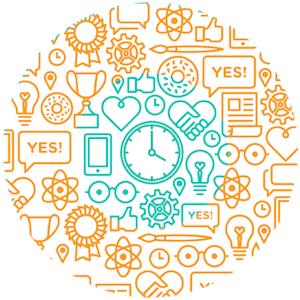A Designer’s Guide to Joining a Startup
We’ve put together a collection of resources to help guide you through the new job process, from what questions to ask about your career and assembling your portfolio, to interviewing and what it takes to be an exceptional designer. We want to share these tips and best practices we’ve learned in hopes that more designers join the right companies and have the tools to be successful.
One of the benefits of joining a top startup through our Bridge program is getting the support you need. We’ll work to make sure you have a smooth transition whether it’s a new role, a new city, or a new country. Our team is available throughout the process to answer questions, provide portfolio feedback, and give advice like the resources below.
Get the design career you want
The first step in looking for a new role is knowing what you’re looking for. Kate Aronowitz spoke during Bridge about getting the design career you want, explaining how to know what your next move is and how to get there. Her 5 guidelines are:
- With every step, keep your goal in mind
- Be a leader (even when you’re not the lead)
- Say yes to unsexy projects
- Don’t make apologies for the important things outside of work
- Keep up to date on your company (and the competition)
Mindfully managing your design career transition
Ben Blumenfeld spoke at Creative Mornings around mindfully managing your design career transition. He talks about the decision process he used when he was leaving Facebook to start Designer Fund.
5 questions designers should ask before joining a startup
When you’re considering joining a new company, especially a startup, it is important to gather key information about what your new role would look like. Here are the questions that we ask in vetting Bridge partner companies:
- Do you believe in the mission?
- Who’s on the team?
- Will you be a partner in making decisions?
- Is there a health culture that values design?
- How much value can you and the company create?
Tips for building a world class design portfolio
Once you know where you’re going, the process starts with building a world class design portfolio. Your portfolio is your potential employer’s first impression of you. The 6 rules of thumb are:
- Quality over quantity
- Structure your projects
- Show process
- Get visual
- Show interactions
- Share your personality with side projects
Interviewing with startups: Tips for designers
The next step is the interview. Interviews can completely change a team’s perception about a candidate. Here are 5 tips for designers interviewing with startups:
- Organize your work
- Do your research
- Develop your career story
- Prepare questions
- Develop a relationship
How to ace your portfolio presentation
But of course, no design interview process is complete without a portfolio review. This is your final chance to leave a positive impression on the larger team you may be joining. We’ve outlined the Do’s and Don’ts of presenting your portfolio and the Weird and Wow ways of presenting yourself.
How to understand and negotiate your startup compensation
You prepared for and had fantastic interviews. You love the team, the mission, the culture and the design team loves you back. You’ve made sure the company is at a size that fits your needs, that there are opportunities for growth, and you know the work you’d be doing short/medium term. Two days later you get that wonderful phone call, “we’d like you to join our team” they say and they lay out the specifics of the offer: $100,000/year salary + healthcare/benefits + 8,000 shares vested over 4 years. A great offer… you think… Here are expert tips from recruiting managers at Flipboard, Stripe, and Pinterest about how to understand and negotiate startup compensation.
- Know your worth
- Understand your total comp
- Calculating your equity
- What’s important to you
- Ask how you’ll be compensated going forward
The right way to accept a job offer
So you’ve received a job offer. Congratulations! The role is exactly what you’ve been looking for, the salary is competitive, the benefits package looks great, you believe in the mission of the company, and they have cold brew on tap! You can’t wait to sign — but you shouldn’t, yet.
East to west coasts: Tips for making a smooth transition
You aced the interview, wowed them with your portfolio presentation, and they’ve made you an offer you can’t refuse. You’re ready to take the plunge, which means moving out to the Bay Area, but you don’t know much about the culture of working in tech. So, with the help of a Bridge alum, we’ve put together a list of coastal variations you should be aware of. We discuss the differences in the nitty gritty, org structure and office life, and communication and relationships between the east and west coasts.
Going pro: What it takes to be a lead designer at a top startup
And finally, you’ve arrived in California and are about to begin your new design role at a startup with a mission to make meaningful impact and a culture that values design. You want to put your best foot forward so here’s what it’s going to take to become a design leader at a top startup:
- Choose the right problem
- Go to ship and beyond
- Build a design culture
- Treat prototyping as design
- Become the everything designer
- Adapt constantly
- Flow with the river
 Get the design career you want
Get the design career you want Mindfully managing your design career transition
Mindfully managing your design career transition 5 questions designers should ask before joining any startup
5 questions designers should ask before joining any startup
 Tips for building a world class design portfolio
Tips for building a world class design portfolio Interviewing with startups: Tips for designers
Interviewing with startups: Tips for designers How to ace your portfolio presentation
How to ace your portfolio presentation
 Understand and negotiate your startup compensation
Understand and negotiate your startup compensation East to west coasts: Tips for making a smooth transition
East to west coasts: Tips for making a smooth transition Going pro – what it takes to be a lead designer at a top startup
Going pro – what it takes to be a lead designer at a top startup
If you’re an experienced product designer, communications designer, or design manager considering new job opportunities, apply to the Designer Fund Bridge Program. Applications are now open.